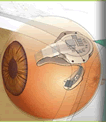
The Future of Vision Robotics
The future of robotic visual enhancement lies within the brain, as many of the most promising current projects involve interaction between the robotics and the portion of the human brain that controls visual processing. This model allows scientists to develop more advanced and precise vision for people who have lost it either through genetic defect or an accident than can be provided by simple physical augmentation of a damaged eye, which may not fix the vision problem, as very often the cause for a lack of vision is damage or defect in the part of the eye that hooks up with the brain.
One such example of a solution to blindness caused by neurological damage is a computer chip which will be attached to the back of the eye connected by a wire to the part of the brain that analyzes visual data. Such a solution would only be helpful for people who were born with the ability to see and developed blindness later in life due to old age or natural deterioration of the cells that connect the eye to the brain. As the technology stands now, this treatment will only work if the optic nerve is still somewhat functional, or the data will not be fully processed. It also requires some sort of camera to receive data and send it to the brain to be analyzed, sending the information it gets back to the chip behind the eye.
With more development, this technology could be developed to the point where complete destruction of the nerves that connect the eye to the brain does not prevent the chip from analyzing visual data. With a more complete understanding of how visible things are analyzed by the brain these images could be completely reproduced without the assistance of the optic nerve. Eyes that are healthy except for this neurological damage will also be the only thing necessary for recording images in stead of a camera (www.thefutureofthings.com).
Robotic eyes made to replace damaged eyes are also increasing in usefulness. A more likely solution to eye damage is not to completely replace the eye with a robot one, but to replace the damaged parts of the eye with robotic analog's of those parts. Otherwise, cameras connecting to the brain could once again bypass any problems presented by the damaged eye (www.seeingwithsound.com).
Another way to increase visibility is by decreasing the amount of input to be analyzed for the person with the robotic eye to see. Development of a vision system using coherent laser radar promises to provide vision that is not affected by changes in lighting, shade, and color. This would provide a much more accurate image that, though lacking in color, would bypass many of the resolution problems that exist in current eye-glasses camera technology used for collecting images and sending them to the brain (www.osti.gov ).
Ultimately, the solution to solving vision problems is the ability to undo or prevent damage to the brain or eye that prevents vision. In the future, as understanding of the human genome increases, the genetic defects that cause many of these eye impairments will be able to be rooted out, making robotic implants unnecessary. The implanting of genes that would cause the developing person to have better vision than they would have without gene therapy will make physical adjuncts to our eyes obsolete. While public opinion is against the use of eugenics now, the development of this science will see fear of the repercussions diminish, along with the need for robotic fixes after the damage is incurred(www.geneticsandsociety.org).














